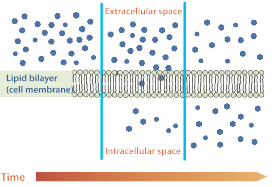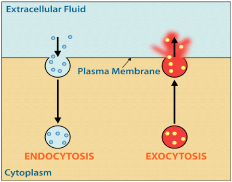Reading: A Study Guide
Key Terms
Homeostasis: Process of maintaining a stable environment inside a cell or an entire organism. Concentration Gradient: A measurement of how much the concentration of a substance changes across a distance.
Passive Transport: Substances cross the cell membrane without the cell providing energy.
Diffusion: A substance moves through a membrane from an area of high concentration to an area of low concentration.
Osmosis: The diffusion of water molecules across a membrane.
Facilitated Diffusion: Diffusion with the help of trans-port proteins.
Transport Protein: Special proteins in the membrane.
Active Transport: A substance moves against the concentration gradient (uses energy from cells).
Sodium-Potassium Pump: When this pump is in operation, sodium ions are pumped out of the cell, and potassium ions are pumped into the cell. Both ions move from areas of lower to higher concentration.
Vesicle Transport: Type of transport in which very large molecules cross the cell membrane. Endocytosis: Type of vesicle transport that moves a substance into the cell. The plasma membrane completely covers the substance, a vesicle pinches off from the membrane, and the vesicle carries the substance into the cell.
Exocytosis: Type of vesicle transport that moves a substance out of the cell. A vesicle containing the substance moves through the cytoplasm to the cell membrane. Then, the vesicle membrane fuses with the cell membrane, and the substance is released outside the cell.
Homeostasis is one of the unifying principles of biology. The concentration of various substances, such as salts and nutrients, needs to be within a certain range in order for a cell to function normally. To maintain this balance, a cell needs to be able to move substances in and out.
Cell membranes are selectively permeable (semipermeable), so some molecules can go in while others can’t.
• Transport proteins or vesicle transports are needed to move hydrophilic and large molecules.
Passive Transport
Passive transport refers to the movement of substances across the membrane without any input of energy from the cell. Three main types of passive transport include:Diffusion, where molecules “move down the concentration gradient” from an area of high concentration to an area of low concentration until equilibrium is reached (the concentration of molecules on both sides of the membrane are equal).

Osmosis, a special type of diffusion specifically referring to the movement of water across a membrane.
Facilitated diffusion, a type of diffusion assisted by transport proteins.
Examples of transport proteins:
Active Transport
Active transport refers to the movement of substances across the membrane that requires an input of energy from the cell. Energy for active transport comes from an energy-carrying molecule called ATP.Energy is required to move substances against the concentration gradient from areas of low concentration to areas of high concentration (contrary to the natural process of diffusion). Energy is also needed to move very large molecules across the membrane.
Like in passive transport, transport proteins are used to move smaller substances.

Larger molecules are transported by vesicle transport.

